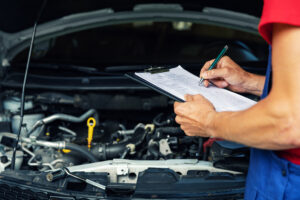
California rolling out salvaged vehicle repair inspections
By onAnnouncements | Legal
After years of development, the California Bureau of Automotive Repair (BAR) is nearing implementation of a stringent inspection program for rebuilt total loss salvaged vehicles.
Gov. Gavin Newsom signed AB 471 into law in 2021, which required BAR to create and implement the inspection program by Jan. 1 of this year. BAR held multiple public workshops in recent years where it received input about the program from the collision repair industry.
California Autobody Association (CAA) has been vocally supportive of The Vehicle Safety Systems Inspections (VSSI) program throughout the process.
“The CAA supported this measure in order to protect consumers from unsafe, revived, total loss salvage vehicles by establishing a safety systems inspection program,” Jack Molodanof, CAA attorney and lobbyist, said in an email. “Currently, to revive a total loss salvage vehicle for use on the public roads [the state] only requires a brake and lamp inspection, smog check, and a California Highway Patrol inspection to make sure there are no stolen parts; nothing else.”
The new VSSI program is replacing a brake and lamp inspection program. All inspection requirements from the old program will be added to the new program, Molodanof said.
Other inspections, such as body structure, steering and suspension, tires and wheels, and passenger compartment will be completed on the vehicles through the new program, Molodanof said. This will involve onboard diagnostics and a road test.
Molodanof said CAA advocates that inspections on advanced driver assistance systems (ADAS) be added as a requirement.
“BAR is considering its inclusion in the near future,” Molodanof said.
Technicians working at VSSI stations must have Automotive Service Excellence (ASE) certification and pass an exam, Molodanof said. Current brake and lamp stations will be grandfathered into the program if they meet the new requirements.
The VSSI regulations are currently pending approval by the California Office of Administrative Law, Molodanof said. He said the approval is expected soon.
BAR released a three-part plan for rolling out the VSSI program last week.
Phase one starts when the regulations take effect, BAR’s plan said. It includes licensing VSSI stations and technicians.
Phase two starts about three months after the regulations take effect, the plan said. This will include the start of VSSI inspections by stations and technicians.
Phase three starts about six months after the regulations take effect, the plan said. It will officially end the brake and lamp inspection program.
Andrew Batenhorst, CAA Glendale/Foothill Chapter president and body shop manager at Pacific BMW, said VSSI is important for consumers and shops.
“In California and most of the country, there are a lot of people who buy a salvaged vehicles from auctions, repair them — usually incorrectly — and put them back on the road,” Batenhorst said. “Now there is a program in place to check those vehicles and make sure they are safe to be on the road.”
The inspection process will track these vehicles, ultimately protecting future shops that come in contact with the vehicles, Batenhorst said.
“The auxiliary benefit is good recordkeeping,” Batenhorst said. “So you aren’t held accountable for something you weren’t involved with.”
Batenhorst said he’s interested to see what the data captured by the program is. The data could help provide information about rebuilt salvaged vehicles.
“It is a little frightening that it has gone on this long without anything,” Batenhorst said. “It has been long overdue and I’m grateful that BAR has taken the time to work on doing this. There was opposition. Those who would oppose this are the ones not repairing vehicles correctly.”
Images
Photo courtesy of ronstik/iPhoto
